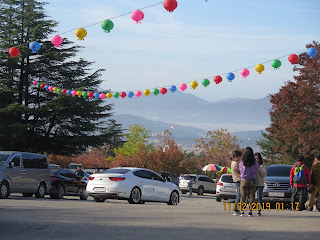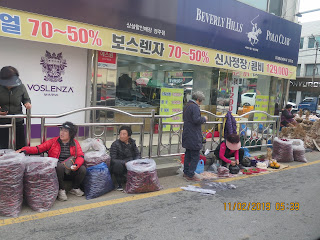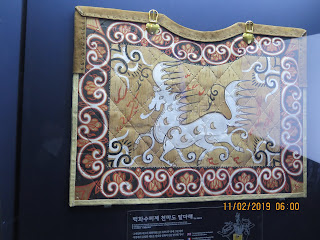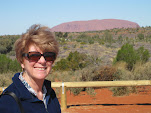November
2nd, Saturday
We ate breakfast downstairs. Aha!
At least 40 people were in the dining room. Where do they have dinner? A few Korean families (they must eat the rest
of their meals with family), and several Anglo tourists. Where do they go? Maybe they have all their meals included in
their tours and they go to one of the buffet style places? Unknown.
Nice layout for breakfast.
At 9 we met our guide, Sonny. She is that, sunny, and her English is quite
good. Off to our very busy day. We asked
her about the teddy bear museum.
Apparently they are quite popular in Asian countries. People dress the bears like characters in TV
shows or famous people, then take photos with them. A bit odd, but who’s to say when we have our
Comicon and Star Wars conventions.
Our first stop was the Bulguksa Temple.
A Buddhist temple on the top of the local mountains. Lovely views and beautiful setting. We were told a lot of information, we were a
bit overwhelmed. The most important
parts were two pagodas. To our right as
we entered the gate was Dagotap Pagoda.
It’s an ornate structure with what looks like a light house on top of a
pillar. There were 4 lions at the base
of the lighthouse, but 3 were stolen by the Japanese. The Japanese did leave a broken one
behind. The history of the objects
around Gyeongiu was that the Japanese took most of them, and returned few of
the stolen items. The pagoda to the left,
Seokgatap, was a more classical pagoda shape with several roof lines, in this
case 3 with a pillar on the very top.
Apparently one of the roof layer stones was broken. While trying to fix it the repairers found a
secret cache of lovely objects hidden in the stones. From the pagodas, the rest of the temple
consisted of 5 buildings each with its own Buddha representation. At the very top of the buildings was one
devoted to Kwanyen. Different
pronunciation for the Koreans, but same deity.
Entrance to Temple
Main steps of main temple
Koreans are master stone masons. Place was built with no mortar - just detailed placing of proper sized rocks
Fish bell under prayer tags
Details of carvings and paintings under roof
Stone stacks for devotion
Beautiful setting in the mountains
Koreans love their piggies - me too
Charlie and me in front of the temple
The size of the buildings, Sonny
explained to us was defined by the spaces between the structural pillars of the
side walls. If there were 4 pillars, one
at each corner two in between, the spaces are called kans. For the 4 pillar side there would be 3
kans. If the perpendicular walls of the
house had 5 pillars, then that length would be 4 kans. The room would be 7 kan sized. (3 + 4) A very wealthy person could have up to a 99
kan house, but only the king could have 100 + kans.
Our next stop was Seokguram
grotto. A dome-shaped grotto at the top
of a hill. Inside the grotto was a large
carving of Buddha made from granite.
Unfortunately we couldn’t take photos, but it was a lovely carving in a
lovely setting. The Japanese, again the
Korean villains, tried to take things from the grotto and partially destroyed
the structure. When they attempted to
fix their mess, they used cement. In the
damp climate of Korea, the stone stature began to mold. The Buddha statue now sits behind glass
windows and is air-conditioned to prevent further mold and damage.
Unfortunately I couldn't sneak in a photo - but the settings in the mountains were gorgeous
We
then had lunch in a little restaurant at the base of the hills. The lunch was fabulous. At least 10 different kinds of pickles –
kimchi (of course), tofu, egg, eggplant, crab, garlic stems, mushrooms, apples
in mayonnaise (better than it sounds), hot tofu soup, lettuce, and the piece de
la resistance – hamburgers a la Korean.
Really delicious. Korean style of
eating these burgers was – piece of burger, chili sauce, little bit of rice on
a lettuce leaf. Fabulous!
Staggering out of lunch, we went
onto the next stop which was Daereungwon tomb complex. The Shilla empire was situated in Gyeongiu. They managed to unit the Korean Peninsula and
reigned from about 57 BC to 935 AD. The
tombs they created were before they became Buddhists. They made huge mounds of rock stone and sand,
and buried the important people in the center bottom of the mounds. The area here was covered with mounds – some
double topped mounds with king and queen inside – some smaller than
others. The Koreans have only excavated
and analyzed a few of these. We could go
into one of the mounds and see what it looked like inside. I found the thought of where I was somewhat
claustrophobic, even though I clearly wasn’t going to be left in there. Across the street from the mounds was an area
that was covered in flowers and canola plants.
Apparently, a building that had been there was destroyed. Because so
many ancient artifacts were there they couldn’t dig down and destroy anything
else, so the area is left fallow. In
this section was an observatory that had been used by Shila royalty to predict
the weather. Farmers expected the royals
to come up with weather knowledge, so the observatory was used for that
purpose.
Ladies selling farm goods (market is here 4 out of 7 days)
One of the burial mounds (hills)
What they uncovered when they opened up the tomb. A coffin with worldly goods
We saw this spirit horse motif all over. Some of the Silla empire designs stayed with the Josean empire too.
Our next stop was the Gyeongiu
National Museum. A lot of the treasures
found in the mounds was on display here.
The most prized position of the museum was a golden crown that was worn
by the queen from the double mounded tomb.
Apparently, the Silla found glass beads more desirable than gold. There were many rooms of pottery and metal
work items. Another room had a 1000 year
old boat that had been found at the bottom of a man-made lake that had been
drained for repairs.
Some of the artifacts of iron and bronze
A golden crown
Another pig - this one looks like he's from Lord of the Rings
The sunken boat
Our last stop was Wolseong. Here the Korean government is attempting to
excavate a tombs and find other ancient artifacts. It’s a slow tedious process. There is a man made lake here surrounded by
pavilions. Very elegant and quite
popular with the locals. The place was
extremely crowded (as were all the sites we saw today). Apparently the lake and pavilions are
beautiful at night, so people were crowding in at the end of the day to get
parking spaces for the lovely walks in the dark.
Back to the hotel for a rest. Tonight small dinner at the again-empty
hotel. Where do the crowds go? Is breakfast their only meal?






















No comments:
Post a Comment